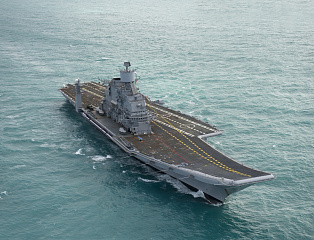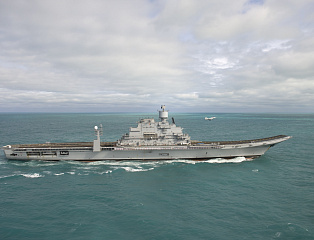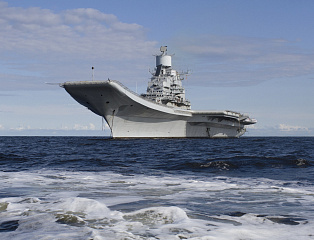press release
On November 16, 2013, the formal handover ceremony and transfer of the Project 11430 aircraft carrier Vikramaditya (INS Vikramaditya) to the Indian Navy will be held at the Sevmash shipyard in Severodvinsk. Vikramaditya, a retrofitted Russian Project 11434 heavy aircraft-carrying cruiser Admiral Gorshkov, will be the flagship of India’s Navy.
The official Indian delegation is headed by the country’s Defense Minister Arackaparambil Kurian Antony.
During the formal ceremony the Russian and Indian sides will sign the certificate of delivery-acceptance transferring the aircraft carrier to the Indian crew and the Indian Navy’s flag will be hoisted on board the ship. The certificate of delivery-acceptance will be signed by aircraft carrier commander Commodore Suraj Berry on behalf of the Indian side and by Deputy General Director of Rosoboronexport (part of Rostec State Corporation) Igor Sevastyanov on behalf of the Russian side.
Commissioning of INS Vikramaditya by the Indian Navy will be an important stage in the development of modern Indian Navy: after a large-scale retrofit at Sevmash the aircraft carrier has received a modern flight deck and a ski jump for take-off of MiG-29K fighters, navigation and radar systems, communications and air control systems, as well as other specialized equipment and units.
The INS Vikramaditya will leave the Russian territorial waters in late November 2013. The ship will carry out a long passage and will arrive in India in late January - early February 2014.
Reference materials for the media
Cooperation between Russia and India In the naval sphere
For decades, Russia was and remains one of India’s key partners, which have played a crucial role in the formation and strengthening of its national naval forces. Since the signing of the first “naval” contract in 1965 to supply four Project 641I diesel-electric submarines, five Project 159E escort ships and five Project 368P boats, more than 70 warships have been built for India at Russian shipyards. Moreover, India became the first foreign customer for which the ships were built according to special export projects. Until that time, only “standard” ships and boats were delivered abroad.
The current agenda of bilateral cooperation in the naval sphere is packed, since India has set itself ambitious goals to strengthen its naval forces which must be capable of effectively protecting the national interests of the country in a huge maritime economic zone and the oceans of the world.
Russia, as India’s long-time strategic ally, is ready to continue to actively help it build up the capabilities of its national Navy.
Commissioning of the aircraft carrier INS Vikramaditya by the Indian Navy will be a major milestone in the development of modern Indian Navy.
Among Russian-made naval weapons and equipment having high potential in the Indian arms market are submarines, frigates and other surface ships, as well as various naval weapon systems.
For example, the Project 11356 frigates have been successfully serving with the Indian Navy for more than ten years and have greatly enhanced its fighting capabilities. In June 2013, the next ship Trikand (Bow) built at the Yantar Baltic Shipyard was handed over to the Indian Navy. The handover completed a contract to build another series of three upgraded Project 11356 frigates for the Indian Navy. These ships are equipped with BrahMos missile systems manufactured by a Russo-Indian joint venture. The first two ships of the series, Tag (Saber) and Tarkash (Quiver), were delivered to the customer in 2012. If necessary, Russia is ready to build another three or four ships of this project with improved characteristics for India on a short schedule.
Another promising area of military-technical cooperation (MTC) in the naval sphere is joint ship design and construction. At present, Russia is assisting India in design and supply of systems and equipment for indigenously developed ships under construction in India, among which are the Projects 15A and 15B destroyers, Project 17 frigates and Project 71 aircraft carrier.
In general, Russia is India’s exceptional and reliable partner which traditionally offers not only the exclusive models of weapons and military equipment, but also know-how: joint projects in MTC confirm a high level of current technological and industrial cooperation; moreover, the current stage of cooperation between the two countries is characterized by a significant increase in the share of joint R&D efforts. Such close cooperation is an important component of Russo-Indian strategic partnership, reflecting an extremely high level of real trust between the two countries and peoples.
Rosoboronexport, a subsidiary of the Rostec Corporation, is the sole state-owned arms trade company in the Russian Federation authorized to export the full range of military and dual-purpose products, technologies and services. Rosoboronexport is one of the leading world arms exporters to the international market. Its share in Russia's military exports exceeds 80 percent. Rosoboronexport cooperates with more than 700 enterprises and organizations in the Russian defence industrial complex. Russia maintains military technical cooperation with more than 70 countries around the world.
The Russian corporation Rostec was established in 2007 with the purpose to render assistance to industries in the development, production and export of high-technology military and civil-purpose products. It comprises 663 enterprises grouped into eight holding companies in the defence industrial complex, and five holding companies in civil industry branches. The Rostec subsidiaries are located in 60 regions of the Russian Federation, and export their products to more than 70 countries worldwide.







